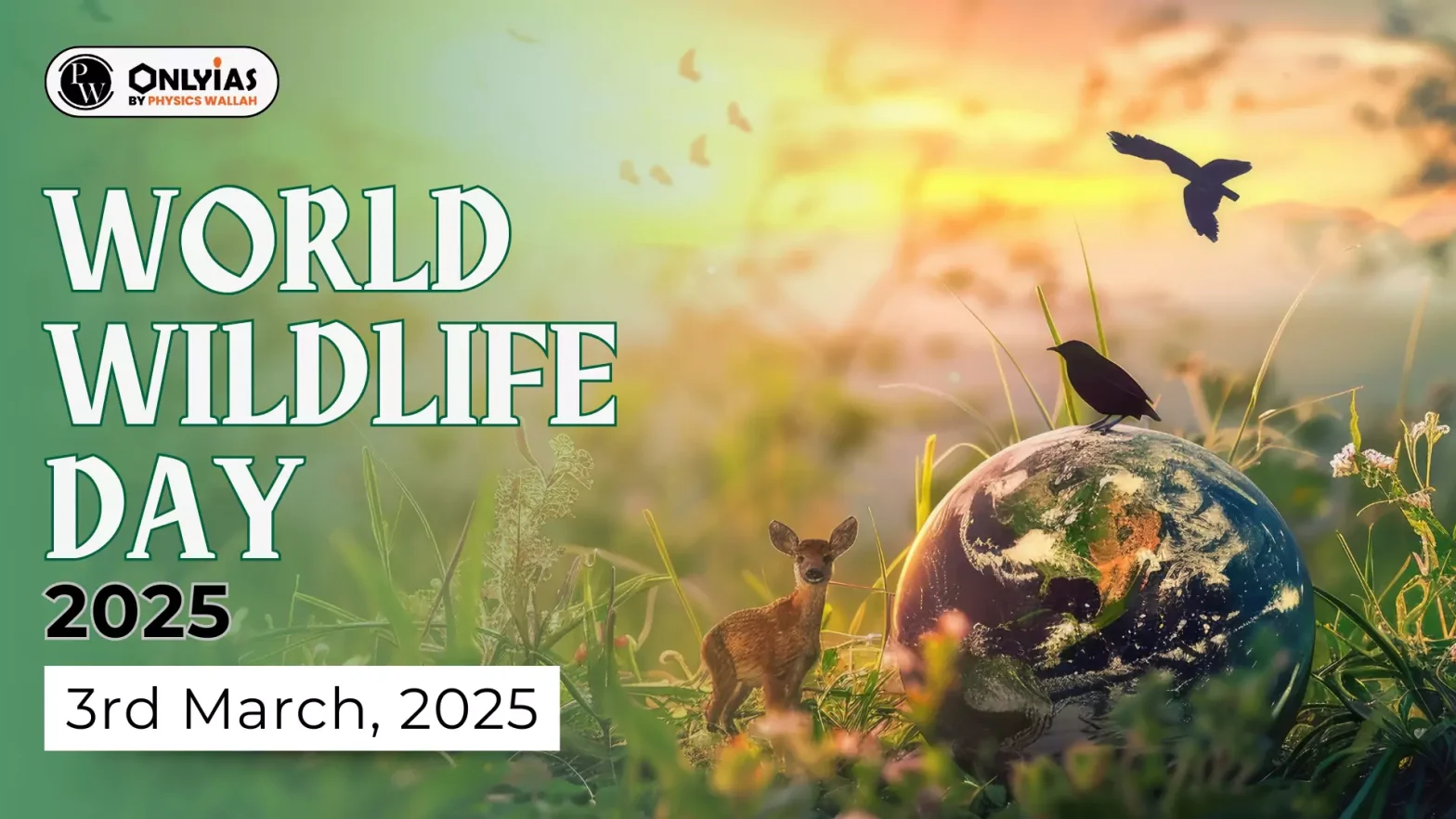World Wildlife Day 2025 promotes biodiversity conservation. Join the movement on World Wildlife Day 2025 to protect endangered species, ecosystems, and wildlife sustainability for future generations.

World Wildlife Day is a global event celebrated every year on 3rd March which is dedicated to celebrating the rich biodiversity of our planet while raising awareness about the challenges facing wildlife. World Wildlife Day 2025 serves as a reminder of the importance of conservation efforts and the need for collective action to protect endangered species and their habitats. Governments, organizations, and individuals come together on this occasion to discuss strategies for sustainable wildlife protection and to promote responsible environmental practices.
World Wildlife Day, observed annually on March 3rd, is an initiative by the United Nations General Assembly (UNGA) to celebrate and raise awareness about the world’s wild fauna and flora. The day was officially declared in 2013 to commemorate the signing of the Convention on International Trade in Endangered Species of Wild Fauna and Flora (CITES) in 1973.
Since its inception in 2014, World Wildlife Day has grown into a global event, emphasizing the importance of biodiversity, conservation efforts, and sustainable practices to protect endangered species. This day is an opportunity for governments, organizations, and individuals to reaffirm their commitment to preserving wildlife for future generations.
| World Wildlife Day 2025 Overview | |
| Aspect | Details |
| Date | March 3, 2025 |
| Established By | United Nations General Assembly (UNGA) |
| Significance | Celebrates and raises awareness about global wildlife conservation |
| Theme for 2025 | “Wildlife Conservation Finance: Investing in People and Planet” |
| Facilitator | CITES (Convention on International Trade in Endangered Species of Wild Fauna and Flora) |
| Global Events | High-level UN celebration in Geneva, online campaigns, film showcase, youth art contest |
| Key Focus Areas | Innovative financial solutions for wildlife conservation, biodiversity protection, and sustainable investment |
| Importance | Addresses biodiversity loss, promotes conservation funding, and encourages global participation |
| Partners | UNDP, WILDLABS, Jackson Wild, International Fund for Animal Welfare (IFAW), and others |
| Call to Action | Governments, NGOs, businesses, and individuals encouraged to support and invest in wildlife conservation |
The United Nations General Assembly (UNGA) established World Wildlife Day on December 20, 2013, to be observed annually on March 3rd. The date was chosen to commemorate the signing of the Convention on International Trade in Endangered Species of Wild Fauna and Flora (CITES) in 1973, an international agreement aimed at ensuring that global trade does not threaten the survival of wildlife species.
Since its first official celebration in 2014, World Wildlife Day has evolved into a significant platform for supporting biodiversity conservation.
The theme for World Wildlife Day 2025 is “Wildlife Conservation Finance: Investing in People and Planet.” This theme highlights the urgent need for sustainable financial solutions to support wildlife conservation efforts. As biodiversity faces threats from climate change, habitat destruction, and illegal wildlife trade, innovative financial mechanisms are necessary to bridge funding gaps and promote conservation.
World Wildlife Day is celebrated to spread awareness about the importance of wildlife and its role in maintaining the health of ecosystems. It aims to
With over 1 million species currently at risk of extinction, the event serves as a global platform to discuss innovative strategies for wildlife preservation and ecological balance.
India has a total of 1014 protected areas, including 106 National Parks, 573 Wildlife Sanctuaries, 115 Conservation Reserves, and 220 Community Reserves, covering 1,75,169.42 km², which is approximately 5.32% of the country’s geographical area. The country is home to over 400 mammal species, 1300 bird species, and more than 600 reptile species. Tiger population in India has increased to 3,682 as per the 2022 census, making India home to 75% of the world’s tigers. The Asiatic Lion is found only in Gujarat’s Gir Forest, with a population of around 674 (2020 census). Conservation programs like Project Tiger (1973) and Project Elephant (1992) have contributed to protecting endangered species, but habitat loss and poaching remain significant threats.
India is a biodiversity hotspot with diverse ecosystems ranging from the Himalayas to the rainforests, deserts, and mangroves. The country hosts:
India is home to over 500 mammal species and 2,000 bird species, making it one of the most ecologically diverse nations. The Western Ghats, Eastern Himalayas, and Indo-Burma region are among the world’s richest biodiversity zones.
Key Wildlife Facts in India
|
|---|
Apart from World Wildlife Day, various countries celebrate National Wildlife Day to promote local conservation efforts. In the United States, National Wildlife Day is observed on February 22nd and September 4th in honour of wildlife advocate Steve Irwin. The day emphasizes raising awareness about endangered species and promoting wildlife rescue and rehabilitation initiatives.
Other countries, including India and Canada, observe national days dedicated to protecting their rich biodiversity. These celebrations provide opportunities for communities to engage in wildlife conservation through educational programs and awareness campaigns.
Funding is a critical component of wildlife conservation, ensuring the success of projects aimed at protecting biodiversity. Currently, an estimated $143 billion is invested annually in biodiversity conservation, but experts suggest that at least $824 billion is needed per year to effectively combat biodiversity loss. Closing this financial gap requires innovative funding mechanisms and international cooperation.
To support wildlife conservation efforts, governments, private organizations, and global institutions are turning to alternative financing solutions. These approaches not only help protect endangered species but also create economic opportunities for local communities.
There are many ways to participate in World Wildlife Day 2025 and contribute to conservation efforts. From personal actions to collective initiatives, every effort counts in ensuring the protection of wildlife and their habitats.
World Wildlife Day 2025 serves as a global reminder of the urgent need to protect biodiversity and invest in sustainable conservation efforts. The theme of “Wildlife Conservation Finance: Investing in People and Planet” emphasizes the critical role of funding in preserving ecosystems and supporting communities dependent on wildlife. With the right policies, financial strategies, and public involvement, we can ensure a thriving planet for future generations.
Explore PW UPSC Courses to deepen your understanding of social justice issues and complete your syllabus for the upcoming exam!
World Wildlife Day 2025 is observed on March 3rd to raise awareness about global wildlife conservation.
The official theme for World Wildlife Day 2025 will focus on sustainability, biodiversity, and conservation efforts worldwide.
It was established by the UN in 2013 to mark the CITES agreement and promote the protection of endangered species globally.
You can join conservation programs, spread awareness, support wildlife organizations, and adopt eco-friendly habits.
Habitat destruction, climate change, poaching, and pollution pose significant threats to wildlife conservation.
It highlights conservation initiatives, strengthens global efforts, and encourages legal actions to protect endangered wildlife.
<div class="new-fform">
</div>
